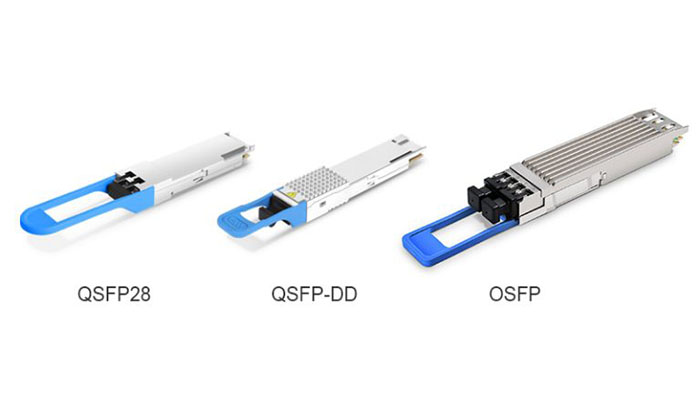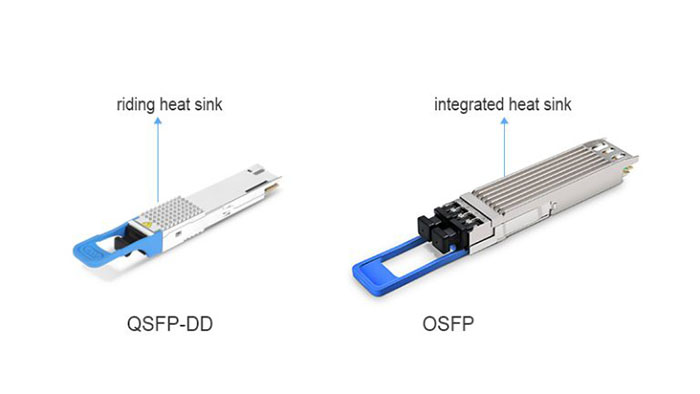

 Knowledge Base +
Knowledge Base +  2024.10.23
2024.10.23400G OSFP and 400G QSFP-DD are the most common 400G module form factors on the market. They share several similarities, including hot-swappable form factor modules, running 8x lanes of 50G on the electrical side adopting PAM4 modulation technology, supporting high-speed 400G data rates for use in data centers, high-performance computing, and telecommunications. However, they differ in many aspects to address different needs regarding size, power consumption, thermal management, backward compatibility, etc. We’re going to discuss the differences in detail in the following parts.
Size:
In terms of size, OSFP is slightly broader and deeper than the more compact QSFP-DD, providing it with more surface area to achieve better heat dissipation capabilities. QSFP-DD shares a similar size with QSFP28, allowing QSFP-DD optics to be inserted into QSFP28 ports, which offers backward compatibility and flexibility in upgrading existing infrastructure. In contrast, OSFP’s larger form factor precludes such compatibility. Still, it enhances thermal management and supports higher power dissipation, making it suitable for high-performance applications that require robust cooling solutions.

QSFP28 vs QSFP-DD vs OSFP
Thermal Management Design
QSFP-DD adopts the traditional riding heat sink design, placing the heat sink on top of the module and relying heavily on the equipment’s airflow for cooling, which can limit its power handling capability in high-density environments. In contrast, OSFP employs an integrated heat sink design, allowing for a more substantial and efficient heat dissipation mechanism within the module.
This integrated approach enhances thermal performance by providing a greater surface area for heat dissipation and supporting advanced cooling technologies. It enables OSFP to manage higher power optics more effectively and maintain lower operating temperatures, resulting in better overall reliability and suitability for high-performance applications.

heat sink of QDD-400G-DR4-S vs OSFP-400G-DR4
Backward Compatibility:
400G QSFP-DD is backward compatible with other existing QSFP derivatives transceivers, such as QSFP+, QSFP28, and QSFP56, giving it high adaptability to seamlessly integrate with the 40G/100G/200G optical transceivers. Also, it is future-proofing for the next-generation 800G QSFP-DD upgrades. Due to its backward compatibility, QSFP-DD maintains the connector contacts at a 0.8 mm pitch and incorporates additional rows of recessed contacts. In contrast, OSFP enhances density by utilizing a 0.6 mm connector contact pitch, compared to the standard 0.8 mm pitch used today. OSFP itself is not directly compatible with QSFP. A QSFP to OSFP adapter converter module is needed to connect the OSFP port to QSFP.
Power Consumption:
Due to its larger size and better thermal management and cooling design, the OSFP can handle a higher power consumption level, typically 15W. OSFP is ideal for more power-mission applications, such as high-performance computing, long-haul telecommunications, and data centers with demanding power requirements. In contrast, QSFP-DD has a lower power upper threshold, theoretically 12W. This lower power handling capability makes QSFP-DD well-suited for applications where power efficiency and lower heat dissipation are prioritized, such as short-reach interconnects and applications with strict power constraints.
Application Technology
QSFP-DD is primarily utilized for Ethernet applications, providing high-speed connectivity for data centers, enterprise networks, and telecommunications. Conversely, OSFP supports Ethernet and extends its compatibility to other high-speed networking protocols, including Nvidia Infiniband. Broader technology capability renders OSFP more versatile, enabling its deployment in a wider array of high-performance computing (HPC) environments and data-intensive applications. Furthermore, OSFP’s enhanced power handling capability and exceptional thermal management design make it suitable for demanding applications in HPC clusters, supercomputing, and artificial intelligence (AI) systems, where high bandwidth, low latency, and efficient cooling are crucial for optimal performance.
Therefore, while QSFP-DD is predominantly used in Ethernet-based networking environments, OSFP’s compatibility with a broader range of protocols, including Nvidia Infiniband, positions it as a versatile and high-performance solution for advanced networking applications across various industries.
| Parameter | QSFP-DD | OSFP |
| Size | 18.35mm× 8.5mm x 89.4mm | 22.58 mm × 13mm x100.4 |
| Backward Compatibility with QSFPxx | Yes | Need QSFP to OSFP adapter |
| Power Consumption | ≤12W | ≤15W |
| Thermal Management | riding heat sink | integrated heat sink |
| 800G Adoption | Yes | Yes |
| Port Density in 1U | 36 | 36 |
| MSA | QSFP-DD MSA | OSFP MSA |
| Application | Ethernet | Ethernet, Nvidia Infiniband |
Conclusion
While both 400G QSFP-DD and 400G OSFP transceivers offer significant advantages for high-speed networking, their differences in size, power consumption, thermal management, and application technology cater to different needs. QSFP-DD’s backward compatibility and compact size make it ideal for Ethernet applications and seamless upgrades in existing infrastructures. Meanwhile, OSFP’s superior thermal management and broader protocol compatibility, including Nvidia Infiniband, make it a versatile solution for high-performance computing environments and data-intensive applications. Choosing the right form factor depends on the specific requirements of the network and the applications it supports.
Subscribe to the newsletter
for all the latest updates.
2-5# Building, Tongfuyu Industrial Zone, Aiqun Road, Shiyan Street, Baoan District, Shenzhen. China
